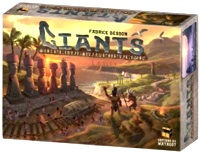
|
About OgreCave and its staff
|

|
by Demian Katz
Giants is certainly not the first game built around the famous stone carvings, or Moaïs, of Easter Island, but it may well be the most attractive. While at heart, it is a moderately abstract Euro-style game of the sort commonly packaged with nondescript wooden pieces, on the surface it looks more like a theme-rich American-style game – the Easter Island equivalent of Axis and Allies. The box is packed with plastic miniatures, and while some die-hard Eurogamers may feel that the elegance of simple wooden pieces is missing here, most people will probably be too entertained by all the miniature stone heads to complain. A lot of care has gone into the sculpting here; the Moaïs and their headgear are an impressive sight by themselves, and the game goes the extra mile by giving each player color a unique set of tribesmen, allowing a lot of visual variety on the board. In spite of the varied miniatures, you can easily tell the function of every figure by the shape of its base.
Gameplay At the start of the game, players are given three tribesmen miniatures: a worker, a chief and a sorcerer. They also get two round plastic tribe markers and a number of square cardboard Moaï bases that varies depending on the number of players in the game. Each player's supply of workers and tribe markers can grow during the course of play. All of these items are placed behind screens, so you have to pay attention if you want to know what resources are available to your opponents. The game ends after one player successfully builds Moaïs on all of his or her bases. Each turn consists of three distinct phases. First, the dice are rolled to determine which and how many Moaïs are sculpted on the current turn, and the players hold an auction to see which players get to carve which Moaïs. Tribe markers bid determine the order in which players get to choose Moaïs, and workers bid determine the size of Moaï that can be claimed. Regardless of whether a player wins a Moaï in the auction, he or she is unable to use the resources bid for the rest of the current turn. After bidding is complete, players take turns placing their tribesmen on the board one at a time, attempting to build a network of workers capable of carrying Moaïs to their destinations. A small Moaï needs only a single worker for transportation; a medium Moaï requires two workers, and a large Moaï requires three. The chief counts as three workers, and log rollers may be placed along with workers to ease the task. At the same time that workers are being placed, several special actions are also available. A tribe marker may be used (placed in front of the player's screen) to obtain a Rongo half-tablet. A sorcerer may be placed in certain special hexes to perform a particular task (obtain logs, gain a worker, gain a tribe marker, carve a headdress, etc.). Chiefs may also be used as sorcerers at the cost of a full Rongo tablet.
Cooperation versus personal advancement When you do manage to transport a Moaï to its final resting place, a memory element comes into play: you put one of your base counters under the figure face down in order to mark it as your own. You can't peek at a base counter without spending a Rongo half-tablet, so it pays to remember where you put your Moaï when it comes time to add a headdress for bonus points! One other important situation can come up during transportation: it is always possible that the worker network won't be quite strong enough to get your Moaï or headdress where you want it, forcing you to leave it on the board until the next transportation phase. If you have a leftover tribe marker, you can use it to mark the stranded piece, indicating that it belongs to you. On subsequent turns, you can resume shifting it toward its destination. On the other hand, if you have run out of tribe markers due to a high auction bid or the acquisition of too many Rongo tablets, your hard-earned sculpture is abandoned as a neutral piece on the board, and another player may be able to snatch it away on the following turn! Eventually, somebody will run out of bases, and at the end of that turn, final scoring begins. Every potential Moaï site has a base score value that is multiplied according to the size of the Moaï placed there. Sites also have a separate bonus score value that is added when a headdress is placed atop the Moaï. Base values get higher the farther you go from the Moaï quarry, and bonus values get higher the farther you go from the headdress quarry. Since the Moaï and headdress quarries are at opposite ends of the island, a lot of different base/bonus scoring combinations are available, offering a variety of strategies and scoring opportunities. Although Moaï placement tends to make up the bulk of a player's score, leftover Rongo tablets also count for a few points, and cooperation early in the game can make a big difference!
Conclusions
|
||||
 Giants
Giants